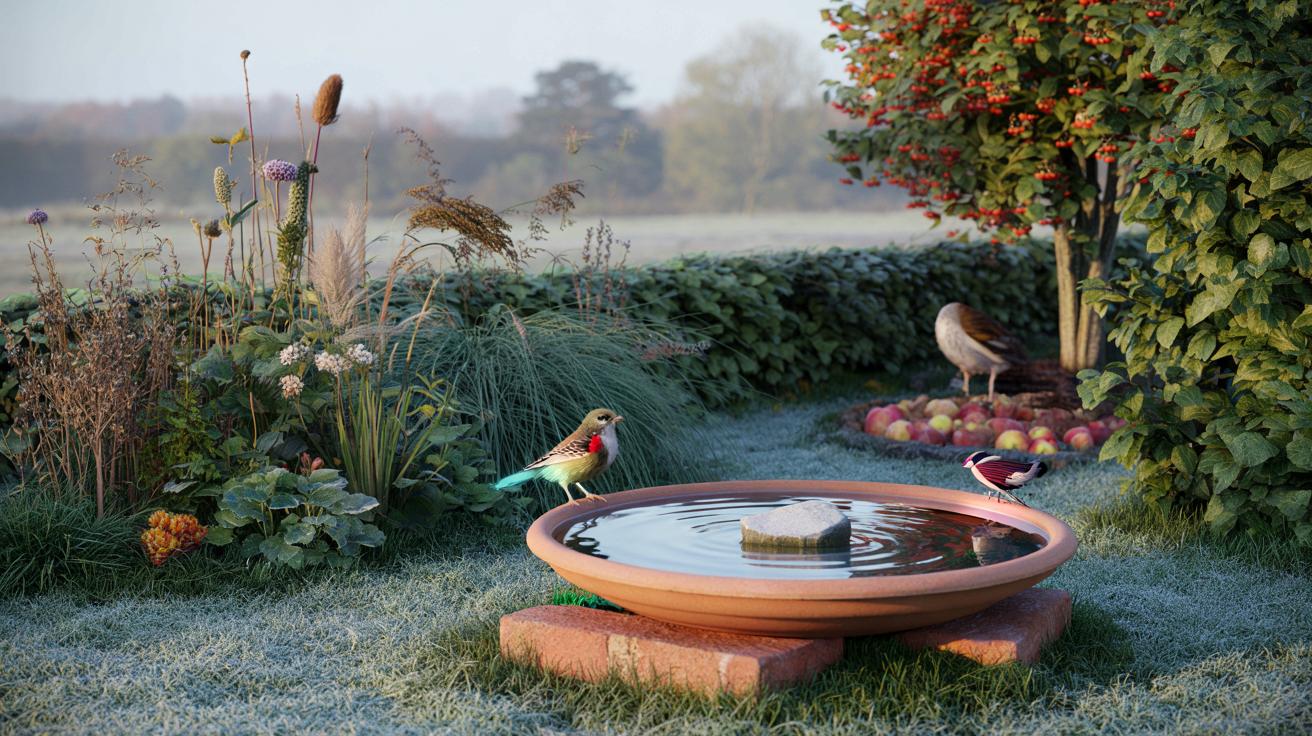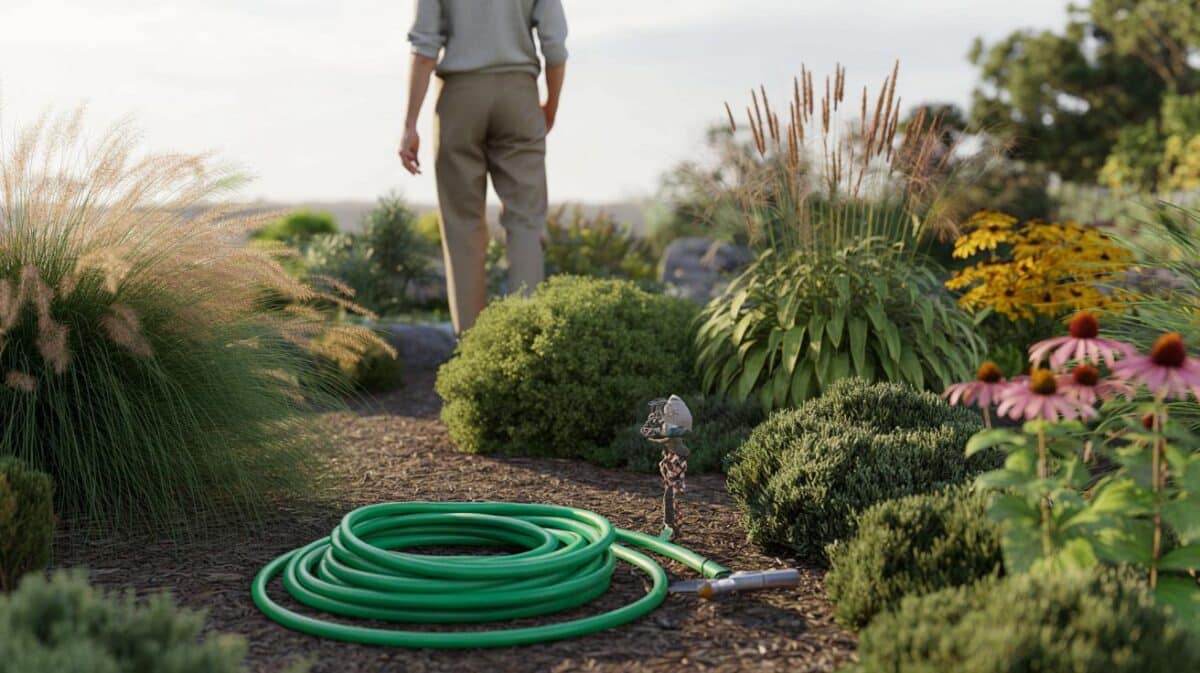Food vanishes. Water freezes. Shelter disappears. Birds simply move on.
There is another way. Small, inexpensive changes in October and November can turn your plot into a winter lifeline. Three steps, a few minutes each week, and you keep robin, wren and tit returning when nights bite.
Why autumn tidy-ups push birds away
Short days drive gardeners to clean edges and clip back growth. Lawns are scalped. Borders are cleared. Leaves are bagged and binned. The space looks neat. The ecosystem empties.
Seed heads hold calories. Hollow stems hold spiders and overwintering insects. Leaf litter shelters beetles and worms. A clipped hedge loses depth and windbreak. A bare border offers no cover from sparrowhawks or cats.
The over-tidying trap: mowing, pruning, bagging leaves
Routine cuts remove the winter pantry. Every seed head taken now is a meal lost in January. Every thicket thinned is a sleeping spot gone on an icy night. A clean line pleases the eye, yet it starves the soil food web that feeds birds from the ground up.
What a lifeless garden means when frost arrives
When temperatures dip, birds need three things: unfrozen water, reliable calories and secure roosts. If none exists on your patch, they travel to the next. Silence follows. Activity drops. You miss out on the winter drama at arm’s length.
Birds stay where two needs meet daily: safe cover within a wingbeat of food and unfrozen water.
Water done right: the shallow bath that keeps flocks stopping by
Liquid water becomes scarce before snow arrives. A shallow bath changes that. It supports drinking and feather care, which improves insulation and flight.
Set out a low, wide dish 5–8 cm deep
Use a terracotta saucer, a baking tray or a shallow bowl. Keep the depth between 5 and 8 cm so small birds can bathe without risk. Place a flat stone in the middle to give grip and an exit step. Raise the dish slightly on bricks to reduce splashing mud and to improve visibility for wary visitors.
Keep it safe, unfrozen and clean
Refresh the water daily in cold spells. Add a mug of warm (not hot) water to melt thin ice. Never use salt or antifreeze. Set the bath 2–3 metres from dense shrubs so cats cannot ambush. Scrub weekly with hot water and a brush, then rinse and dry before refilling.
Depth matters: 5–8 cm is ideal; a stone for footing reduces slips and keeps birds bathing for longer.
Seed heads and wild fruit: a natural buffet that costs nothing
Natural food beats novelty feed. Perennials and grasses store energy above ground. Hedgerow shrubs hang berries well into winter. You save money by leaving what the garden already made.
Leave grasses and perennials standing until march
Keep teasel, sedum, coneflower, rudbeckia, fennel and cosmos upright. Finches pick them clean. Leave ornamental grasses and wild patches for siskin and sparrow. Even a few square metres of uncut border can carry flocks through a cold snap.
Swap mystery fat balls for real berries and fallen fruit
If you use feeders, avoid plastic mesh that traps feet. Better yet, plant and save. Hawthorn, rowan, crab apple, dog rose, ivy and viburnum carry fruit at staggered times. Leave windfalls from apple or pear under trees. Thrushes and blackbirds take them when ground freezes.
Don’t strip the stage: seed heads feed by day; berrying shrubs feed at dusk; both provide perches between bursts of cold.
Hold the secateurs: delay pruning to build shelter
Structure keeps birds on site. Thick hedges break the wind. Brush piles hide roosts. Untouched corners trap heat near the ground. You can still shape the garden. You just move the timing.
Dense hedges and brush piles block wind and hide predators
Leave hedges and big shrubs until late winter. Pile twiggy prunings in a quiet corner to form a 1 m wide, 60 cm high shelter. Tuck leaves into the base. That mix warms at night and protects from cats by day.
Why spring is the right time to cut
Late-winter trims keep berries and cover available through the hardest weeks. Check for active nests from early spring into summer and avoid cutting when birds breed. A slow, staggered cut keeps a living screen in place all year.
Cut late, not hard: postpone big pruning until winter eases, and keep at least one side of a hedge dense.
Three steps under £10 that work
- Water: a £5–£8 terracotta saucer, 30–40 cm wide, filled to 5–8 cm, refreshed daily in cold spells.
- Food: leave at least 50 seed heads per 10 m² and collect windfalls in one visible pile for ground-feeders.
- Shelter: create a 1 m brush pile and delay hedge cutting until late winter to maintain a windbreak.
What to plant now for winter and next year
| Plant | What it offers | When it helps | Who benefits |
|---|---|---|---|
| Hawthorn | Dense cover, red haws | Autumn to late winter | Thrushes, finches, robins |
| Teasel | Sturdy seed heads | Autumn to mid-winter | Goldfinches, siskins |
| Sedum | Flat heads, insects sheltering | Autumn and mild spells | Tits, wrens |
| Ivy | Late nectar, berries, cover | Late autumn to spring | Blackbirds, woodpigeons |
| Ornamental grasses | Seeds, standing cover | All winter | Sparrows, buntings |
Practical placements that reduce risk
Put the bath where you can see it from indoors. Position it 2–3 metres from shrubs, with open sightlines to reduce ambush. Keep feeders, if used, either within 1 m of windows or more than 10 m away to reduce collisions. Move the windfall pile away from fences that cats patrol.
Aim for a mixed layout: one open feeding spot, one dense refuge, and one water source. That triangle keeps birds cycling between safety, feeding and bathing without crossing open ground for long.
Numbers that guide your set-up
Small birds can burn 10–20 per cent of body mass overnight in cold weather. They top up from dawn to mid-morning, then again before dusk. A 30–40 cm saucer serves a small garden. One brush pile per 50 m² adds cover. Leaving 20–30 per cent of your plot “untidied” through winter supports insects that rebound in spring.
Hygiene and welfare without fuss
Rinse baths with hot water weekly. Scrub surfaces, then dry before refilling. If you run seed feeders, empty old seed and clean regularly to reduce disease risk. Rotate feeding spots to avoid trampled, damp ground. Remove any netting that can trap feet.
A quick model for a 5 × 10 m garden
North corner: a brush pile 1 m across. South edge: a 35 cm terracotta saucer on two bricks with a flat stone inside. Central border: 2 m² left standing with sedum, rudbeckia and grasses. East side: a hawthorn or crab apple for berries and shelter. This layout costs under £20 if you buy a shrub; under £10 if you use existing plants and found materials.
Seasonal timing that keeps birds coming
October–November: install the bath, mark areas to leave standing, create the brush pile. December–January: refresh water daily, top up windfalls, resist cutting. February–March: shape hedges lightly as the worst cold passes, then pause once nesting starts. April onwards: note which plants were most visited and add more for next year.








